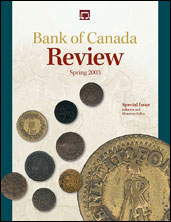May 23, 2003
The Bank of Canada: Moving Towards Transparency
During the 1990s the Bank of Canada made several changes that transformed its conduct of monetary policy. In the 1960s and 1970s, policy decisions were made in an environment characterized by instrument opaqueness and goal opaqueness, which tended to shield the Bank's operations from scrutiny and accountability. Since the 1970s the Bank has moved towards transparency and openness by rejecting multiple policy instruments and adopting a single, well-defined goal of inflation control.
A recent survey has shown that the Bank of Canada is in the middle range of central banks with regard to its transparency and has lost points for not publishing the forecasts that shape its policy or the minutes and voting records of its governing body. Chant suggests that the public has benefited significantly from the changes the Bank has made, but that it should continue to support research on the benefits of low and stable inflation and continually inform other policy-makers and the public of the results.
